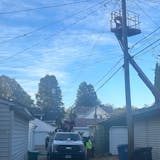On a recent Tuesday night, Straightline Dance Fitness studio in northeast Minneapolis could barely contain the pulsating energy of a couple of dozen hip-hop dancers.
Amid laughter and encouraging shouts, the local dancers worked out different styles. Michael Ingram led a joyful voguing routine while Herb Johnson, joined by his 9-year-old niece Vhlincia Love, deconstructed the intense, warrior-like krumping technique. Other dancers spun on their backs or popped into one-arm handstands. A break dancer used the ballet barre for support while balancing on his head.
This kind of "session" is frequent at Straightline (not to mention other hot spots like the Minneapolis College of Art and Design and Central Mission in St. Paul).
"Minnesota is a gold mine when it comes to hip-hop culture," offered Joshua Dudley (aka Big Snubb), a krump specialist interviewed by phone from Portland, Ore. He visited the Twin Cities recently to judge the Uprising 3 Battle competition.
"We are respected on a national level at least and probably international, too," added local dancer Jason Noer (aka B-boy J-Sun). "We're the third largest breaking community in the country. We are cross-generational and cross-cultural and while there's still gender inequality, we're working on it. We're known for our hospitality and our style."
Yet even as the Twin Cities hip-hop dance scene has flourished and garnered accolades, its proponents are still seeking recognition from the larger dance community. Their specific goal? More performance opportunities in artistic and commercial settings, from the Cowles Center to the Mall of America.
"I can name on one hand the number of venues that produce hip-hop," asserted Maia Maiden, founder of the annual "Rooted: Hip hop Choreographer's Evening" at Intermedia Arts. And this puzzles her, given the size and commitment of our local hip-hop community. "We're here, we've been here, we're not that hard to find," she added.
Audiences are ready for more hip-hop dance, said Dayna Martinez, artistic director of world music and dance and the International Children's Festival at the Ordway Center. She says hip-hop as a concert dance form is "not much of a leap" for American audiences anymore. Take, for example, the historically important Jacob's Pillow Dance Festival in the Berkshires and the Joyce Theater in New York. "They've been presenting hip-hop for a really long time," she noted.

